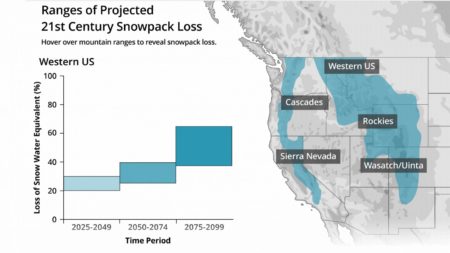The Science
Mountain snowpack acts as a large natural reservoir, providing water resources to communities, ecosystems, energy and industry upon spring snowmelt. Because up to 75% of western the region’s water resources originate in mountainous watersheds, decreasing snowpack threatens resiliency of the systems that depend on snowmelt water. This research synthesizes historical observations of western U.S. snow loss over the 20th century and develops a range of projected snowpack conditions in the 21st century. This study highlights that it is likely that western U.S. snowpack will decrease substantially over the next ~35-60 years, especially if high greenhouse gas emissions continue.
The Impact
Comparable to recent western snowpack declines, future snow losses are projected to decrease 20-30% by the 2050s and 40-60% by the 2100s. But there’s potential to build resilience to future low-to-no snow conditions using a portfolio of adaptation strategies. Models used to project future water cycle changes need to be improved to provide water resource managers with estimates that are better suited to decision making. The development of new atmosphere-through-bedrock modeling capabilities are needed, and could greatly benefit from non-traditional scientific-stakeholder partnerships.
Summary
This study synthesizes observational evidence of snow loss in the western U.S. over the 20th century and develops a range of projected snowpack conditions in the 21st century, elevating the understanding and importance of snow loss on water resources. Results show that there is less consensus on the time horizon of future snow disappearance, but that model projections suggest that if carbon emissions continue unabated, low-to-no snow conditions will become persistent in ~35–60 years, depending on the mountain range. We propose a new low-to-no snow definition which uses a percentile approach, akin to the U.S. Drought Monitor, and considers sequencing of 1, 5, or 10 low-to-no snow years via a framework describing those losses as “extreme, episodic, or persistent.” Potential trickle down impacts on mountain landscapes, hydrologic cycles, and subsequent water supply are also discussed. For example, diminished and more ephemeral snowpacks that melt earlier will alter groundwater and streamflow dynamics, but the direction of these changes are difficult to constrain given competing factors such as higher evapotranspiration, altered vegetation composition, and changes in wildfire behavior in a warmer world. A re-evaluation of long-standing hydroclimatic stationarity assumptions in WUS water management is urgently needed, given the impending impacts of snowpack loss. These hydroclimatic changes undermine conventional western U.S. water management practices, but through proactive implementation of soft and hard adaptation strategies, there is potential to build resilience to extreme, episodic and, eventually, persistent low-to-no snow conditions. Finally, suggestions are provided for the scientific breakthroughs, management strategies, and institutional partnerships that will be needed to overcome a future with less or no snow. Co-production of knowledge between scientists and water managers can help to ensure that scientific advances provide actionable insight and support adaptation decision-making processes that unfold in the context of significant uncertainties about future conditions.
Citation
Siirila-Woodburn, E.R*., A.M. Rhoades*, et al. “A low-to-no snow future and its impacts on water resources in the western United States” Nature Reviews Earth and Environment. (2021) [DOI: 10.1038/s43017-021-00219-y] Open access: https://rdcu.be/cAivm. *Equally contributing first-author.

